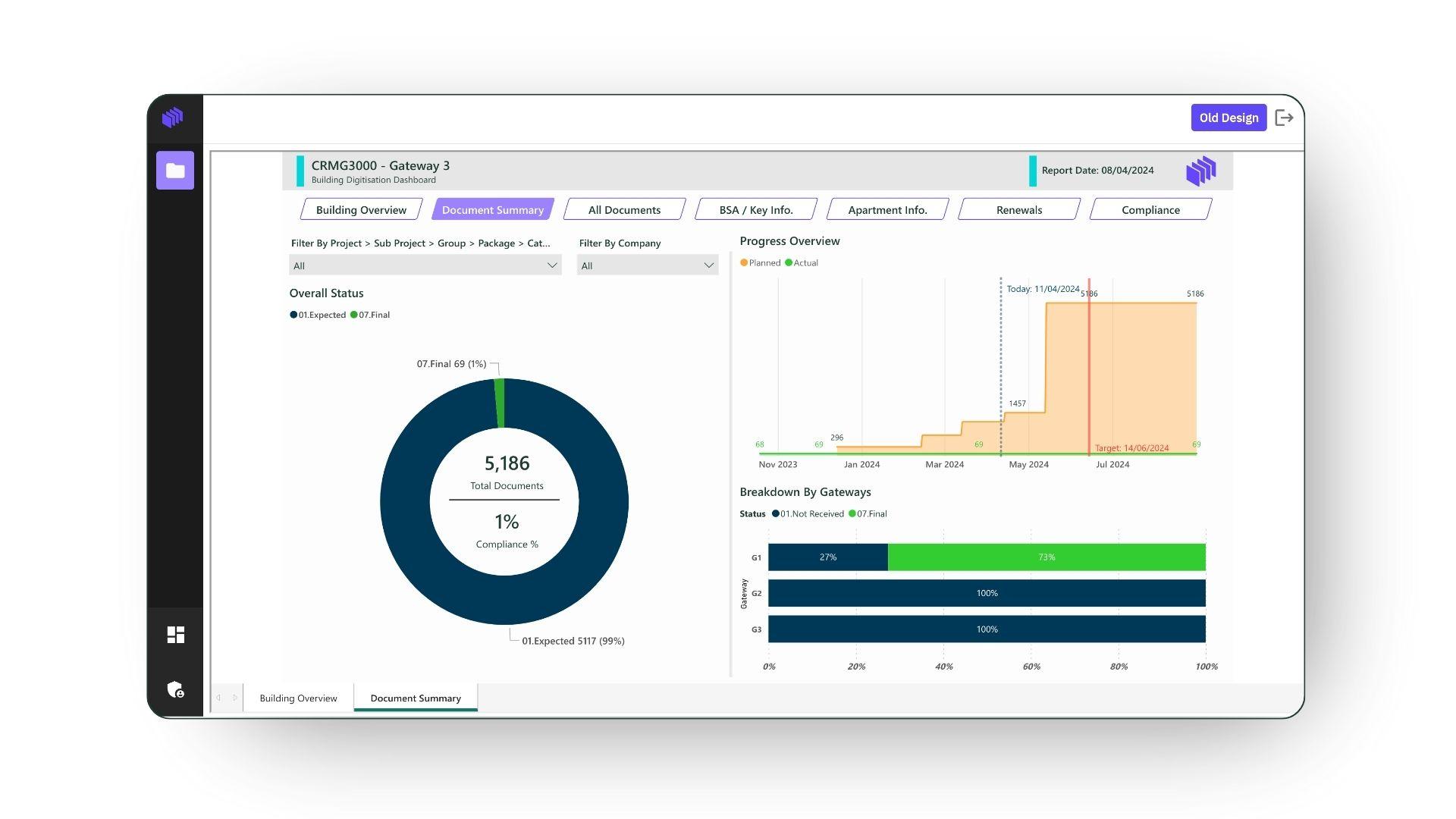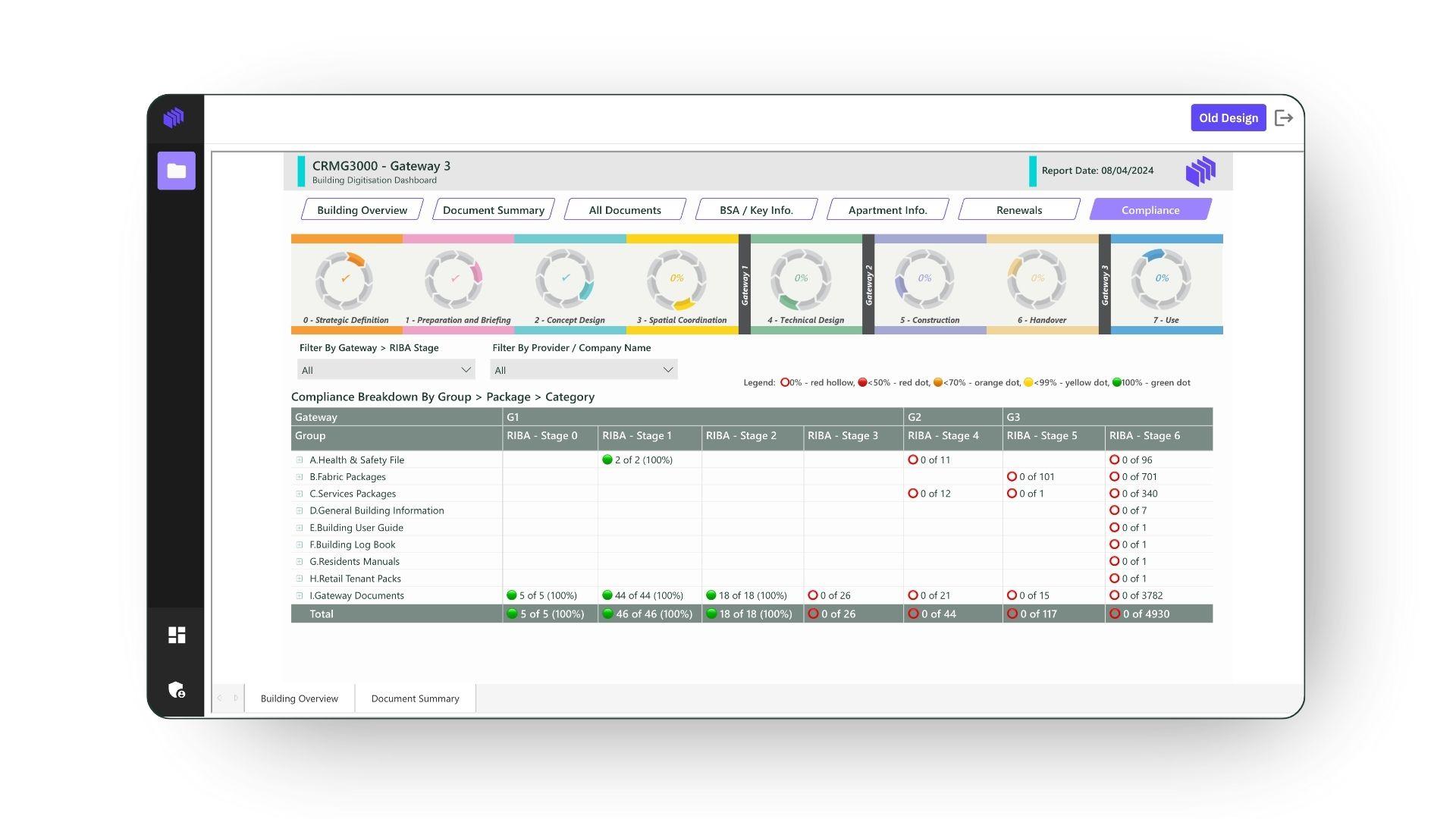The Key Building Information deadline
Deadlines have passed to register higher-risk residential buildings (HRRB) with the Building Safety Regulator (BSR), and now from the 1st of October 2023, it will be an offence to allow residents to occupy an unregistered building. New buildings completed after 1 October 2023 must have a relevant completion certificate and be registered before being occupied. For all registered buildings key building information needs to be provided to the BSR about the building’s structure and fire safety within 28 days.
For background reading on Key Building Information requirements, read our blog, ‘Navigating Key Building Information: Countdown to Compliance’.
What does the Key Building Information deadline mean for asset owners?
This BSR deadline has wide-reaching implications for asset owners. If an asset owner doesn’t have all their building information digitised, they will find it increasingly difficult to account for documentation around Key Building Information such as fire and smoke controls or the type of structure, roof, staircases and external walls associated with a building. Registering HRRBs is one thing, but submitting the supporting Key Building Information is another.
Without a solution that can identify information gaps and track document compliance in line with BSR requirements, it will make submitting this information that much harder. It will be even harder still to keep information up to date and accurate for when next April comes around when a safety case is required and the BSR starts to call in buildings for assessment if it’s not stored in a central platform that can help with information management and compliance.
This key building information deadline marks the first step towards realising the new BSR building safety framework. Those who aren’t ready will have to get their house in order soon to avoid hefty fines. So, what are the next steps for those looking to get compliant fast?
Prepare for high-risk building compliance
Process, structure, categorise, and review all your building documents in one platform.
Next steps for asset owners
Step 1: High-Risk Building Compliance
New Building Safety Act obligations mean that it’s now non-negotiable for asset owners to maintain a digital record of data including critical fire safety information. In the past, it was the responsibility of the building control officer to find non-compliance, but now the onus is on the asset owner to prove compliance. Being able to account for building information is now a vital pillar of asset management in order to demonstrate regulatory compliance. At the same time, leveraging digital platforms for High-Risk Building Compliance to consolidate data and documentation will allow asset owners to make more informed decisions, reduce risks, and ultimately optimise the performance and value of their properties. When digitising building information, it’s important to consider the following:
Building Safety First: Maintain a digital record of data including critical fire safety and maintenance information on your journey to maintaining a Golden Thread of information. With capabilities to edit records too, your information can always be up to date, with changes tracked and stored. This makes handing over a building to Facility Management easier, creates an audit trail of changes and underpins building safety management throughout the asset lifecycle.
All Your Documents in One Place: Building digitisation involves consolidating all relevant building information into a single digital platform. This comprehensive data management ensures that nothing falls through the cracks and that you have an accurate and up-to-date representation of your entire property portfolio.
Identifying Data Gaps: Ensuring effective oversight of building information across a portfolio can be a lengthy process. By digitising all building-related data, you can easily spot gaps in your information. Addressing these data gaps becomes crucial for maintaining the safety and operation of your properties.

Step 2: Choose the right technology for your contractors
Choosing the right technology for contractor collaboration is a pivotal component of a modern asset management strategy, especially within the context of a new regulatory landscape. By ensuring that the contractors you work with are aligned with your digital handover efforts and strategy by using a common platform for data submission and communication, you can achieve consistency, efficiency, and better oversight across your entire property portfolio. This not only helps with compliance tracking but also sets standards and empowers you to make data-driven decisions, ultimately enhancing the value and performance of your properties. When considering technology, it’s worth bearing the following aspects in mind:
Consistency in Data Delivery: Implementing a standardised digital platform for contractors ensures that they consistently deliver information in a structured format. This consistency is crucial for maintaining the integrity and accuracy of your building data across a portfolio. It eliminates the risk of receiving disparate data formats or incomplete information, making it easier to manage and analyse the data effectively and avoid holdups at Project Completion (PC).
Efficient Compliance Tracking: With contractors using the same platform, tracking compliance becomes a seamless process. You can establish clear guidelines and requirements for data submission, including key building information and safety cases so you can deliver an as-built record on every building and maintain a ‘Golden Thread’ of information. This standardised approach allows you to easily monitor whether contractors are meeting compliance standards across your entire property portfolio.
Convenience: Holistic View of Building Information: Typically, today, building information is still siloed, and stored across disparate systems and formats owned by multiple parties, with differing quality and completeness — and a challenge to make sense of it all. Instead, own all your data on a single digital platform that is structured to meet your internal processes.
Step 3: Register Higher-Risk Residential Buildings & submit Key Building Information
Registering Higher-Risk Residential Buildings and submitting Key Building Information is now a critical phase in asset management. It involves the processing and categorising of structural and fire safety data so it’s in one place when you’re ready to share it with the regulator to meet regulatory deadlines and ensure compliance. Beyond regulatory requirements, this step provides an opportunity to enhance safety, mitigate risks, and maintain a responsible and proactive approach to asset management. This new legislation has two components:
Deadline Compliance: The 30th of September 2023 deadline was not arbitrary; it was mandated by the Building Safety Regulator to ensure that residential buildings meet essential safety requirements. Failing to meet this deadline can result in legal and financial consequences.
Submitting Key Building Information: Having all structural and fire safety information organised and readily accessible is beneficial not only for meeting the 28-day deadline but also for ongoing asset management. By providing transparent and comprehensive information to the regulator, you reduce the likelihood of safety-related incidents and potential legal issues. Using a consolidated platform and document management for High-Risk Building Compliance ensures that you have a comprehensive record of your building’s safety measures, making compliance easier to achieve.
Step 4: Safety Case Report
Safety Case Report is now a pivotal phase in asset management under the BSR’s new regulatory framework. Essentially it ensures compliance with safety regulations to maintain the well-being of building occupants. For occupied buildings, this needs to be submitted by April and involves the consolidation of safety-related information, the use of specialised tools like golden thread dashboards, and efficient document management solutions. A well-prepared Safety Case Report should not only meet regulatory requirements but also proactively mitigate risks and promote transparency in asset management. Several factors should be considered when building out your Safety Case Report:
Safety Case Components: The Safety Case Report is a comprehensive document that outlines the safety measures and compliance status of your buildings. It typically identifies a building’s major fire and structural hazards and information on how they will be managed and controlled should an incident occur. It includes information related to building design, construction, materials, fire safety systems, evacuation plans, maintenance records, safety inspections, and more. The report serves as evidence that your buildings meet essential safety standards.
Document Management Templates: Efficient document management templates are essential for organising and maintaining the extensive paperwork required for a Safety Case Report. These solutions help categorise, store, and retrieve documents related to building safety, ensuring that all necessary records are readily available when needed.
Information Review and Gap Identification: Using dashboards, asset owners can systematically review the information they hold about each building. This review process helps identify any gaps in the safety case. Addressing these gaps is critical for maintaining the safety and compliance of your buildings.
Step 5: Golden Thread of Information
Golden Thread of Information is about establishing and maintaining a comprehensive and organised flow of information throughout a building’s lifecycle. It ensures that the building is operated safely and effectively, that compliance is maintained, and that decision-making is informed by historical data. By embracing the golden thread concept, asset owners can enhance the value, safety, and sustainability of their property portfolios.

Safety and Compliance: The golden thread of information is particularly crucial for safety and compliance. It allows asset owners to track and demonstrate that the building consistently meets safety regulations and standards over time. This is vital for maintaining the safety of occupants and minimising legal and financial risks.
Treat information as a valuable asset: Information lies at the core of the Golden Thread and is crucial for making it successful. It’s important to start viewing information as an important asset in its own right on par with the physical facility. When parts of an asset register are copied across multiple systems that don’t work together and have inconsistent names and arrangements, it won’t give a solid basis for operating built assets effectively or in accordance with compliance.
Centralised Information Management: The key to maintaining the golden thread is the centralised management of all structural and fire safety-related information that is interoperable with other systems across the supply chain. By pulling in disparate data to manage document collation, actions, approvals, gateways and compliance in a single dashboard you can have all your building information and processes in one place. A well-organised digital repository ensures that all relevant stakeholders, including property managers, facility maintenance teams, and regulatory authorities have access to the most up-to-date information.
Information exchange: The golden thread of information is especially valuable during transitions between dutyholders, from design and construction to managing and monitoring a building. It ensures that knowledge is not lost during these transitions and that the building’s history and operational requirements are seamlessly passed on to the next responsible party.
To find out more and take full control of Key Building Information, get in touch with our expert team to arrange a consultation and demo.